AI Emotion Recognition has emerged as a groundbreaking technology, enabling machines to analyze and interpret human emotions through facial expressions, voice tones, and other behavioral cues. This innovative application combines artificial intelligence and psychology to revolutionize various sectors. From enhancing customer experiences to improving mental health diagnostics, AI emotion recognition tools are redefining how businesses and individuals interact. The rise of AI Emotion Detector apps and online platforms makes this technology accessible to a broader audience, offering valuable insights and actionable data.
AI Emotion Recognition enables organizations to customize their offerings as per user needs. This ensures meaningful connections. In this blog, we will uncover the top use cases of AI emotion recognition, applications, benefits, and tools available in this niche.
Need AI Integration Services? Click Here
Top 10 Use Cases of AI Emotion Recognition
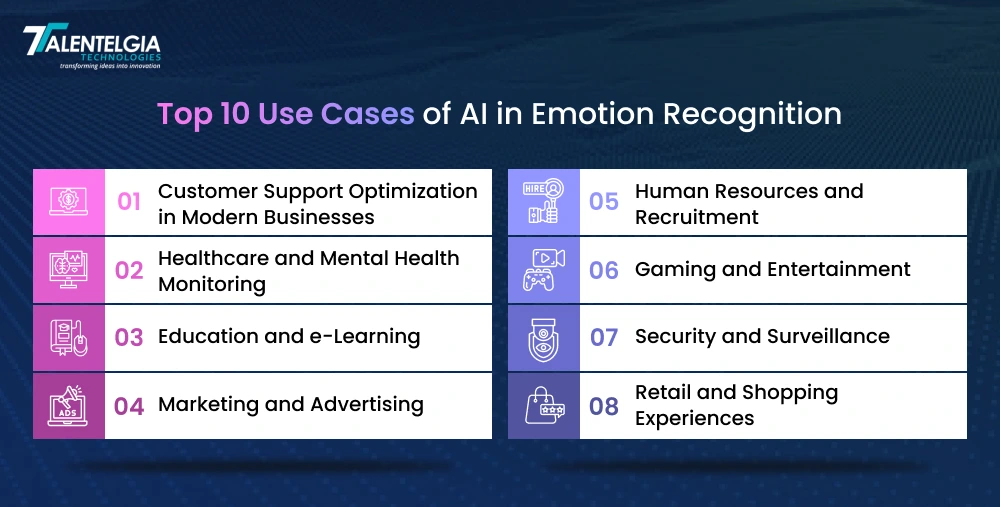
AI Emotion Recognition is transforming industries by finding new ways of understanding and responding to human emotions. Improving customer support, and upgrading healthcare services its use cases are diverse, but impactful for businesses. Today, businesses can gain deeper insights into user behavior by using AI Emotion Detector apps and online tools, hence making interactions meaningful. This section explores the top ten use cases of AI Emotion Recognition, showcasing its practical applications, benefits, and challenges.
1. Customer Support Optimization in Modern Businesses
AI Emotion Recognition is a game-changer in customer service, changing interactions into more empathetic experiences that are actually effective. By checking the emotions of customers via voice tone, facial expressions, and behavioral patterns, emotion-detecting AI may predict frustration or satisfaction in real-time. For instance, during a phone call or chat, it can identify stress and escalate an issue for a senior representative to resolve. Additionally, it can provide agents with tailored suggestions to address specific customer concerns effectively.
This technology also helps in identifying recurring issues that often lead to dissatisfaction, allowing businesses to refine their services proactively. Moreover, emotion recognition systems can be integrated into self-service platforms, enabling them to respond dynamically based on user mood.
How it Helps Businesses
AI-driven emotion recognition tools empower companies to build stronger relationships with customers, leading to higher retention rates and increased customer loyalty.
AI emotion recognition can revolutionize customer service by detecting customer emotions during interactions. For instance, emotion detector AI can identify frustration or dissatisfaction in real time and escalate the call to a human agent. This ensures a quicker resolution and improved customer satisfaction.
Pros
- Enhanced customer experience through personalized support.
- Faster response times and improved issue resolution rates.
Cons
- Risk of inaccuracies in detecting complex emotions.
- Privacy concerns regarding sensitive customer data.
Quick Read: AI in Business
2. Healthcare and Mental Health Monitoring
AI emotion recognition is really revolutionizing the monitoring of mental health through early detection and individualized treatment. AI can easily identify early signs of mental issues like anxiety, depression, and stress. This is done by analyzing your facial features, speech, and voice variations. For instance, you can equip wearable devices with an AI-powered emotion recognition system. These systems can monitor the time-variability of states associated with emotions, providing a panoramic view of a patient’s mental health.
The technology will also have hope for remote care services where it is not possible to physically visit patients due to distance constraints. AI tools for emotion recognition can bridge these gaps by continuous assessment of patient emotional states that can lead to necessary interventions at proper times. In therapy settings, the technology may be used to assess a patient’s emotional responses in real-time so that therapists may adjust their approach to make for a more effective therapeutic experience. Real-time insights make doctors and therapists diagnose patients better and give the best care, as they treat each patient individually.
However, any type of health technology raises questions relating to data and the ethical way of using a patient’s sensitive emotions. In conclusion, AI can do much regarding mental health by improving it and must be integrated with enough care for privacy at the patient end and ethics used in handling data.
How it Helps Businesses: For health providers, AI emotion recognition will give the capability of targeted treatments and therapies with emotional insight and, thus, better care delivery. By diagnosing conditions early and tailoring treatment plans to individual emotional patterns, providers can enhance patient outcomes and reduce the need for frequent visits. This leads to a more efficient healthcare system and better patient satisfaction.
Pros
- Non-invasive monitoring allows healthcare professionals to track emotional health without requiring invasive procedures or frequent visits.
- AI systems enable early diagnosis of mental health conditions, allowing for timely interventions that can prevent conditions from worsening.
Cons
- Privacy concerns arise as sensitive emotional data is collected and analyzed, requiring strict data protection measures.
- The ethical implications of using AI to assess emotional states must be carefully considered to avoid potential misuse.
3. Education and e-Learning
AI emotion recognition tools are revolutionizing the field of education. This is through tracking student engagement in online learning. AI emotion detectors can check students’ responses to course material through facial expressions, body language, and tone of voice. For example, if a student is confused or frustrated, an AI system can alert the teacher to change content or resources. This level of emotional insight provides educators with the opportunity to offer more personalized learning. This level of emotional insight allows educators to offer a more personalized learning experience tailored to individual student needs.
Additionally, AI emotion recognition can identify disengaged or distracted students. AI systems can respond to the appearance of boredom or disinterest by suggesting different ways of learning, for example through interactive elements or more engaging course material, so that student attention and interest are refocused. Real-time feedback allows adapting the delivery of a course, so satisfying students better while achieving better learning results.
With online classes and e-learning, this technology can be implemented to better improve the curriculum according to the student’s emotional and cognitive needs. AI will have the capability of tracking the response of emotions for multiple sessions to yield valuable data in helping the teacher improve teaching skills.
However, cultural differences and diverse emotional expressions pose challenges to the accuracy of AI emotion recognition systems. While these systems are effective in many contexts, they may struggle to interpret emotional cues from students of different cultural backgrounds, potentially leading to misunderstandings.
How it Helps Businesses: For EdTech companies, AI emotion recognition can provide tailored educational solutions that improve student engagement and retention. By offering personalized learning experiences based on emotional feedback, businesses can boost student satisfaction and improve educational outcomes, which in turn enhances their reputation and attracts more users.
Pros
- Improved learning experiences result from real-time emotional feedback, enabling educators to adapt content to better meet students’ needs.
- Personalized teaching methods increase student engagement, helping them retain information more effectively.
Cons
- AI emotion recognition may have limited accuracy in culturally diverse settings, leading to potential misinterpretations of emotional cues.
- Students may feel uncomfortable being monitored for their emotional responses, raising concerns about privacy and consent.
4. Marketing and Advertising
Marketers are embracing AI emotion recognition. It is done to implement impactful advertisements that connect with the target audience. These AI machines have the ability to quantify emotional responses toward advertisements through real-time evaluation of facial movements. This then allows marketers to determine which aspect of a specific advertisement elicits positive or negative emotions.
For example, a highly engaging ad that appeals based on emotions can be modified for the greater good, and an adverse response might force the brand to change some aspects to engage its audience better. Additionally, AI tools give insights into intensity and advise on adjustments that make the ad evoke the intended feelings in the target market.
How it Assists Businesses
Emotion-based marketing can really make a huge difference in branding messaging. Using this form of marketing lets companies create ads that will really connect on a deeper emotional level with audiences. Analyzing emotional responses through feedback can be optimized in improving campaigns for higher engagement and an increase in conversion rates. That way, there is a better return on investment, and those people who have an emotional connection with a brand are likely to purchase from that brand and hold loyalty to it.
Pros
- Emotion-driven marketing fosters deeper connections with the audience, leading to more personalized and effective advertising.
- It helps businesses refine their messaging based on real-time emotional feedback, ensuring higher engagement.
Cons
- The technology may not always accurately interpret emotions, leading to misinterpretation of audience reactions.
- Collecting emotional data can raise privacy concerns if not handled transparently.
5. Human Resources and Recruitment
Emotion recognition AI injects a fresh, high level of analysis in the recruitment space by detecting a candidate’s response to various emotional stimuli during an interview. Rather than assessing what one says, AI technology depends on non-verbal communication such as facial expressions, gestures, and voice pitch to gauge one’s emotional state. For instance, the extent of nervousness or low self-esteem of a candidate may come through via microexpressions, and hence the recruiter would need to further probe or alter the evaluation norms. Such emotional information enables an assessment of candidates with respect to their potential cultural fit in an organization to become more holistic, not only in terms of job fit but also concerning organizational values.
How it Helps Businesses:
Emotion recognition in recruitment allows more insight into candidates, turning the process holistic. The introduction of emotional clues in assessments saves businesses from poor hiring mistakes by reducing turnover rates, thereby cutting costs on hiring and boosting productivity as well as morale, thus paving the way for a workplace culture that indirectly affects the eventual success of your company.
Pros
Emotion recognition allows companies to see the emotional intelligence of a candidate and can help understand them the culture of an organization. Emotion recognition works in balancing other traditional assessment methods by giving them a wider sense of a candidate’s fit.
Cons
There are ethical issues that can arise with using emotion-based tests to bring people into their company. The technology can be biased and could misread a person’s emotional signals to draw a conclusion.
6. Gaming and Entertainment
AI emotion recognition will mark a new frontier in the gaming and entertainment world by making the user experience both interactive and personalized. It will automatically adjust to the gameplay given the player’s feelings-for example, increasing the level of difficulty if he is too calm or offering reassuring guidance when he appears frustrated. It will also be able to suggest content to the viewer based on his emotional state on streaming platforms, such that the user is suggested films or shows that match their current mood. This will provide an immersive and interactive form of entertainment that is more engaging since it responds directly to the viewer or player’s feelings in real time.
How it Helps Businesses:
It helps businesses enhance the gaming experience and provide personalized recommendations on content, thereby helping businesses improve their user retention and satisfaction. Indeed, more often, players and viewers stay with platforms that offer experiences personalized to their emotions. This, apart from ensuring user loyalty, leads to high revenues due to subscriptions, in-game purchases, or content consumption.
Pros
Higher user engagement through a better experience results in better retention rates.
Mood-based content recommendations will keep the users satisfied and come back for more regularly.
Cons
Real-time emotional analysis may be technically challenging and not always accurate.
Too much reliance on emotional data could make the suggestions monotonous or predictable, ultimately reducing overall variety.
7. Security and Surveillance
For alerting against suspicious behavior, emotion recognition via AI is surely crucial in today’s scenario and has to be done in real-time. Applications in public spaces or high-traffic areas can involve analyzing the emotional state of crowds to predict threats-for example, through the detection of increased anxiety or aggression. This technology can also be extended to monitor individuals in security-sensitive environments such as airports or events. AI will alert security personnel to potentially dangerous situations before they escalate, hence improving response times and public safety by understanding these emotional cues.
How it Helps Businesses:
AI Emotion Recognition in Security helps businesses and authorities respond in advance against any potential security threat, hence reducing the occurrence of an incident. Early detection of suspicious behavior will enhance safety, provide a better experience for customers, and reduce business risk.
Pros
- Improves public safety by detecting threats through emotional cues of aggression or distress.
- Quick response times prevent incidents from getting out of hand.
Cons
- There are considerable ethical and privacy concerns in monitoring the emotional states of people without consent.
- It may result in some false positives where innocent behavior is taken as suspect.
8. Retail and Shopping Experiences
Emotion recognition technologies also help retailers analyze customers’ emotional responses while shopping. Whether it is online or in-store shopping, AI can detect the mood of a shopper and whether that shopper is satisfied, frustrated, or excited. The AI might even be linked to product recommendations based on the shopper’s mood, or perhaps specific discounts and promotions. With a deeper understanding of customer emotions, retailers can create a more engaging shopping experience that will feel truly personalized and responsive to the shopper’s needs and wants.
How It Helps Businesses:
Emotion recognition helps businesses drive sales, as it depicts a more personalized shopping experience, tugging right at the emotions of the customers and thereby leaving them highly satisfied and loyal to the business. Also, such insight will improve inventory management and marketing strategies whenever analytics point out what exactly appeals to a customer.
Pros
- It would offer personalized customer interaction that leads to satisfaction and loyalty.
- It will help businesses optimize product recommendation, promotion, and customer service.
Cons
- It raises several issues with privacy because collecting emotional data without clear consent may violate customer rights.
- Misinterpreting the emotional states might result in inappropriate product suggestions or promotions.
9. Event Management
Event organizers increasingly use emotion detection to understand the audience in real-time. It will refine event strategy and improve audience engagement. This also lets event organizers know which moments of an event had more impact on audiences and can thus be repeated or leveraged. This would bring in the analysis of attendee satisfaction, helping the organizers make modifications in the flow of events, environment, or presentations to make it more engaging for all.
How it Helps Businesses:
Event organizers can use real-time emotional data to ensure a highly engaging and successful event. By responding to emotional feedback, they are able to enhance the overall experience of attendees. This leads to better attendance at future events, increased brand awareness, and higher satisfaction by participants.
Pros
- Real-time feedback allows for immediate adjustments, enhancing attendee engagement.
- Helps refine event strategies for better audience retention and satisfaction.
Cons
- Ineffective it will prove if overall strong infrastructure does not support the implementation of emotion detection and data management.
- There might be an over-dependence on emotional data hence decisions could become emotionally biased.
10. Autonomous Vehicles
Emotion recognition through AI in autonomous vehicles finds application in monitoring the states of drivers and passengers to avoid accidents. It can depict the signs of distress or tiredness by analyzing facial expressions, body language, and voice tone. If the system recognizes any such signs, it can make a driver aware of stopping for rest. It can even go further to adjust the driving experience based on the emotions of the passengers.
How It Helps Businesses
Emotion recognition technology makes vehicles a lot safer for automobile manufacturers and insurance companies. It avoids accidents due to the emotional state of the driver. A business that integrates this into its models will help in increasing safety, reducing accident rates, and reducing insurance costs for both the company and its customers.
Pros
- Improvement in vehicle safety by monitoring the emotions of the drivers, thereby preventing accidents because of stress or fatigue.
- Lastly, there will be the avoidance of liability both from car manufacturers and insurance firms through early handling of safety concerns.
Cons
- There will be a high cost in regard to installation when mounting emotion-recognizing technology in vehicles.
- There is also concern regarding emotional data collected on drivers and passengers.
AI Emotion Recognition Applications
AI emotion recognition is an advanced technology that analyzes and interprets human emotions through various cues, such as facial expressions. Its applications span a wide range of industries, offering groundbreaking solutions to enhance user experiences and improve operational efficiency. By understanding emotional responses, businesses can create personalized, emotionally intelligent interactions. This will not only drive engagement but also build deeper connections with their audiences.
In healthcare, AI emotion recognition has the potential to revolutionize mental health diagnostics and patient monitoring. They detect signs of stress, anxiety, or depression in real time.
In retail, it enables personalized shopping experiences that cater to customers’ emotional states, leading to increased satisfaction and loyalty. When it comes to the education sector, it plays a pivotal role in enhancing student engagement and improving learning outcomes. The system identifies emotional cues and adapts content to better suit individual needs. The entertainment industry also benefits from AI emotion recognition by delivering adaptive content that aligns with a viewer’s mood.
Lastly, in security, AI emotion recognition can detect suspicious behaviors or threats in public spaces. It analyzes the emotional responses of individuals in a crowd, ensuring safer environments.
These are just a few examples of how AI emotion recognition is shaping various industries, with the potential for even broader applications as the technology evolves. By tapping into this emotional intelligence, businesses can unlock new opportunities for growth, innovation, and improved customer relationships.
- AI emotion recognition has broad applications across industries. Key areas include:
- Healthcare: Mental health diagnostics and patient monitoring.
- Retail: Personalizing customer experiences based on mood.
- Education: Enhancing student engagement and learning outcomes.
- Entertainment: Providing adaptive content based on user emotions.
- Security: Detecting suspicious activities in public spaces.
Benefits of AI Emotion Recognition
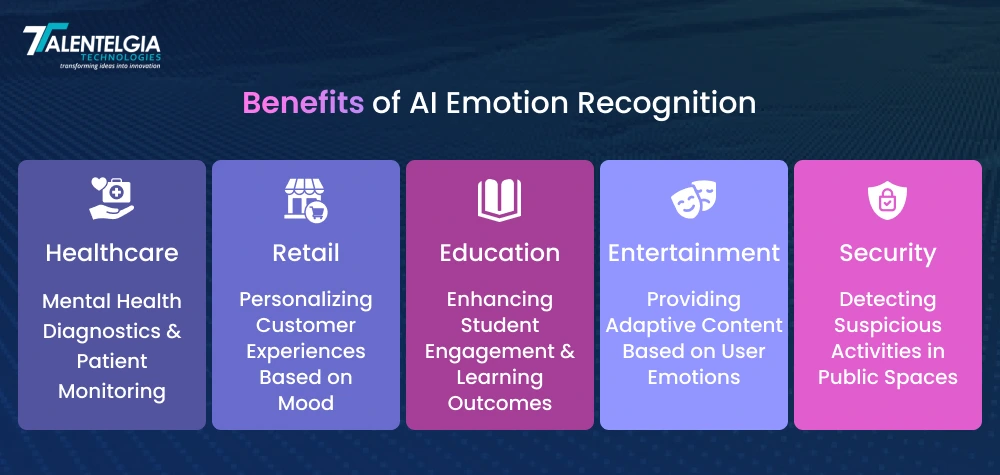
AI emotion recognition is rapidly emerging as a transformative technology, capable of analyzing human emotions through facial expressions, speech patterns, body language, and other subtle cues. With its ability to provide deep insights into how individuals feel and respond to various stimuli, AI emotion recognition is unlocking new opportunities across numerous industries. By understanding emotional responses in real-time, businesses and organizations can personalize experiences, improve safety measures, enhance customer engagement, and increase operational efficiency. This technology has broad applications in healthcare, retail, education, entertainment, and security, helping organizations respond more effectively to the needs of their customers, clients, and stakeholders.
Let’s explore in more detail how AI emotion recognition is applied in these key sectors:
1. Healthcare: Mental Health Diagnostics and Patient Monitoring
In healthcare, AI emotion recognition is proving to be a valuable tool for mental health diagnostics and patient monitoring. By analyzing emotional cues such as facial expressions, voice tone, and speech patterns, AI can detect early signs of mental health issues like stress, depression, or anxiety. This enables healthcare professionals to intervene earlier, potentially preventing the progression of these conditions and offering timely, personalized treatment options.
AI-powered wearables and apps are also being used to monitor a patient’s emotional state throughout the day. These devices provide real-time feedback to both the patient and their healthcare provider, allowing for continuous emotional tracking. For example, if a patient shows signs of emotional distress during a particular time of day or after certain events, this data can be used to assess whether any therapeutic adjustments are necessary. Moreover, therapists can assess patients’ reactions during sessions in therapy settings and fine-tune approaches for more effective treatment by the use of emotion recognition.
2. Retail: Personalizing Customer Experiences Based on Mood
In the retail sector, AI emotion recognition is transforming the way brands engage with their customers. By analyzing shoppers’ facial expressions and body language, businesses can gain real-time insights into a customer’s emotional state—whether they are feeling happy, frustrated, confused, or satisfied. This information allows retailers to personalize the shopping experience on the fly, adapting their approach based on the customer’s mood.
For example, if a customer looks frustrated while trying to find a product, a store associate could be prompted to offer assistance. Alternatively, AI systems could adjust the digital display, offering recommendations that align with the customer’s emotional state. In online retail, AI-driven websites can provide personalized product recommendations based on a customer’s emotional responses during browsing. This creates a more engaging and dynamic shopping experience, which can increase customer satisfaction, encourage repeat business, and ultimately drive sales.
3. Education: Enhancing Student Engagement and Learning Outcomes
In the field of education, AI emotion recognition has a significant impact on enhancing student engagement and improving learning outcomes. As students interact with course materials or instructors, AI systems can monitor facial expressions, body language, and voice tone to assess emotional responses. This allows educators to gauge student engagement levels, identify moments of confusion or frustration, and adapt the content or teaching methods accordingly.
For instance, if a student appears disengaged or confused during a particular lesson, AI systems can recommend modifications to the course, such as providing more examples, offering additional resources, or incorporating interactive elements to regain the student’s attention. This ability to adjust learning experiences in real time helps improve overall student satisfaction and performance. Furthermore, AI can identify students at risk of falling behind, allowing educators to intervene early and offer personalized support, ultimately enhancing learning outcomes.
4. Entertainment: Providing Adaptive Content Based on User Emotions
The entertainment industry is another sector benefiting greatly from AI emotion recognition. Streaming platforms, gaming companies, and content creators are increasingly using this technology to provide a more personalized, immersive experience for users. By analyzing viewers’ emotional reactions during content consumption—whether they’re watching a movie, playing a game, or listening to music—AI systems can adjust the experience in real time to match the user’s mood.
For example, a streaming platform could change the genre of content recommendations based on a viewer’s emotional state. If a user seems bored or disengaged, the platform might suggest a more exciting or uplifting movie. Similarly, in gaming, AI can modify gameplay elements such as difficulty levels, narrative choices, or character interactions based on the player’s emotional responses. This dynamic approach not only enhances user satisfaction but also boosts engagement and retention rates, as users feel more connected to the content.
5. Security: Detecting Suspicious Activities in Public Spaces
AI emotion recognition is also transforming security, as it detects suspicious activities in real time. By analyzing the emotional states of individuals in public spaces, AI systems can identify signs of anxiety, aggression, or other abnormal behaviors that may signal potential threats or criminal activity. For example, in a crowded setting such as an airport or stadium, AI can track emotions through facial expressions and body language, providing security personnel with real-time alerts if an individual appears to be acting out of the ordinary.
This use of emotion recognition can significantly enhance public safety by enabling security teams to respond faster and more accurately to potential risks. In high-stress situations, such as public events or crowded areas, identifying emotional cues like fear, panic, or anger can help prevent violent incidents or disturbances. However, privacy concerns must be addressed, and careful implementation of these systems must be ensured by organizations.
Top 10 AI Emotion Recognition Tools & Apps
AI emotion recognition tools and apps are revolutionizing the way businesses and organizations understand and interact with their audiences. By analyzing emotional cues such as facial expressions, speech patterns, and body language, these tools provide valuable insights into human emotions, enabling more personalized, engaging, and responsive experiences. In this section, we explore the top 10 AI emotion recognition tools and apps that are leading the charge in various industries, helping businesses enhance customer interactions, improve services, and increase overall satisfaction.
- Affectiva
- IBM Watson Tone Analyzer
- Realeyes
- Kairos
- Emotion AI by Microsoft
- Noldus FaceReader
- Google Cloud Emotion AI
- Amazon Rekognition
- DeepSight AI
- Sighthound
Conclusion
AI Emotion Recognition is revolutionizing how businesses interact with their customers and improve internal operations. By understanding emotions, companies can provide personalized services, enhance safety, and drive better outcomes across industries. With continuous advancements, this technology promises even greater possibilities for fostering meaningful human-machine interactions. Investing in AI emotion recognition online or integrating emotion detector AI into your systems can give businesses a competitive edge, ensuring long-term growth and innovation.
Frequently Asked Questions (FAQ)
How does AI Emotion Detector work?
It works by analyzing data from various inputs, such as video or audio, to determine emotional states using machine learning.
What industries benefit the most from AI Emotion Recognition?
Industries like healthcare, retail, marketing, education, and security benefit significantly from AI emotion recognition.
Are there any ethical concerns with AI Emotion Recognition?
Yes, privacy, data misuse, and potential biases are some ethical concerns associated with this technology.
What are the best tools for AI Emotion Recognition?
Top tools include Affectiva, IBM Watson Tone Analyzer, Realeyes, and Amazon Rekognition.


 Healthcare App Development Services
Healthcare App Development Services
 Real Estate Web Development Services
Real Estate Web Development Services
 E-Commerce App Development Services
E-Commerce App Development Services E-Commerce Web Development Services
E-Commerce Web Development Services Blockchain E-commerce Development Company
Blockchain E-commerce Development Company
 Fintech App Development Services
Fintech App Development Services Fintech Web Development
Fintech Web Development Blockchain Fintech Development Company
Blockchain Fintech Development Company
 E-Learning App Development Services
E-Learning App Development Services
 Restaurant App Development Company
Restaurant App Development Company
 Mobile Game Development Company
Mobile Game Development Company
 Travel App Development Company
Travel App Development Company
 Automotive Web Design
Automotive Web Design
 AI Traffic Management System
AI Traffic Management System
 AI Inventory Management Software
AI Inventory Management Software
 AI Software Development
AI Software Development  AI Development Company
AI Development Company  AI App Development Services
AI App Development Services  ChatGPT integration services
ChatGPT integration services  AI Integration Services
AI Integration Services  Generative AI Development Services
Generative AI Development Services  Natural Language Processing Company
Natural Language Processing Company Machine Learning Development
Machine Learning Development  Machine learning consulting services
Machine learning consulting services  Blockchain Development
Blockchain Development  Blockchain Software Development
Blockchain Software Development  Smart Contract Development Company
Smart Contract Development Company  NFT Marketplace Development Services
NFT Marketplace Development Services  Asset Tokenization Company
Asset Tokenization Company DeFi Wallet Development Company
DeFi Wallet Development Company Mobile App Development
Mobile App Development  IOS App Development
IOS App Development  Android App Development
Android App Development  Cross-Platform App Development
Cross-Platform App Development  Augmented Reality (AR) App Development
Augmented Reality (AR) App Development  Virtual Reality (VR) App Development
Virtual Reality (VR) App Development  Web App Development
Web App Development  SaaS App Development
SaaS App Development Flutter
Flutter  React Native
React Native  Swift (IOS)
Swift (IOS)  Kotlin (Android)
Kotlin (Android)  Mean Stack Development
Mean Stack Development  AngularJS Development
AngularJS Development  MongoDB Development
MongoDB Development  Nodejs Development
Nodejs Development  Database Development
Database Development Ruby on Rails Development
Ruby on Rails Development Expressjs Development
Expressjs Development  Full Stack Development
Full Stack Development  Web Development Services
Web Development Services  Laravel Development
Laravel Development  LAMP Development
LAMP Development  Custom PHP Development
Custom PHP Development  .Net Development
.Net Development  User Experience Design Services
User Experience Design Services  User Interface Design Services
User Interface Design Services  Automated Testing
Automated Testing  Manual Testing
Manual Testing  Digital Marketing Services
Digital Marketing Services 
 Ride-Sharing And Taxi Services
Ride-Sharing And Taxi Services Food Delivery Services
Food Delivery Services Grocery Delivery Services
Grocery Delivery Services Transportation And Logistics
Transportation And Logistics Car Wash App
Car Wash App Home Services App
Home Services App ERP Development Services
ERP Development Services CMS Development Services
CMS Development Services LMS Development
LMS Development CRM Development
CRM Development DevOps Development Services
DevOps Development Services AI Business Solutions
AI Business Solutions AI Cloud Solutions
AI Cloud Solutions AI Chatbot Development
AI Chatbot Development API Development
API Development Blockchain Product Development
Blockchain Product Development Cryptocurrency Wallet Development
Cryptocurrency Wallet Development About Talentelgia
About Talentelgia  Our Team
Our Team  Our Culture
Our Culture 
 Healthcare App Development Services
Healthcare App Development Services Real Estate Web Development Services
Real Estate Web Development Services E-Commerce App Development Services
E-Commerce App Development Services E-Commerce Web Development Services
E-Commerce Web Development Services Blockchain E-commerce
Development Company
Blockchain E-commerce
Development Company Fintech App Development Services
Fintech App Development Services Finance Web Development
Finance Web Development Blockchain Fintech
Development Company
Blockchain Fintech
Development Company E-Learning App Development Services
E-Learning App Development Services Restaurant App Development Company
Restaurant App Development Company Mobile Game Development Company
Mobile Game Development Company Travel App Development Company
Travel App Development Company Automotive Web Design
Automotive Web Design AI Traffic Management System
AI Traffic Management System AI Inventory Management Software
AI Inventory Management Software AI Software Development
AI Software Development AI Development Company
AI Development Company ChatGPT integration services
ChatGPT integration services AI Integration Services
AI Integration Services Machine Learning Development
Machine Learning Development Machine learning consulting services
Machine learning consulting services Blockchain Development
Blockchain Development Blockchain Software Development
Blockchain Software Development Smart contract development company
Smart contract development company NFT marketplace development services
NFT marketplace development services IOS App Development
IOS App Development Android App Development
Android App Development Cross-Platform App Development
Cross-Platform App Development Augmented Reality (AR) App
Development
Augmented Reality (AR) App
Development Virtual Reality (VR) App Development
Virtual Reality (VR) App Development Web App Development
Web App Development Flutter
Flutter React
Native
React
Native Swift
(IOS)
Swift
(IOS) Kotlin (Android)
Kotlin (Android) MEAN Stack Development
MEAN Stack Development AngularJS Development
AngularJS Development MongoDB Development
MongoDB Development Nodejs Development
Nodejs Development Database development services
Database development services Ruby on Rails Development services
Ruby on Rails Development services Expressjs Development
Expressjs Development Full Stack Development
Full Stack Development Web Development Services
Web Development Services Laravel Development
Laravel Development LAMP
Development
LAMP
Development Custom PHP Development
Custom PHP Development User Experience Design Services
User Experience Design Services User Interface Design Services
User Interface Design Services Automated Testing
Automated Testing Manual
Testing
Manual
Testing About Talentelgia
About Talentelgia Our Team
Our Team Our Culture
Our Culture
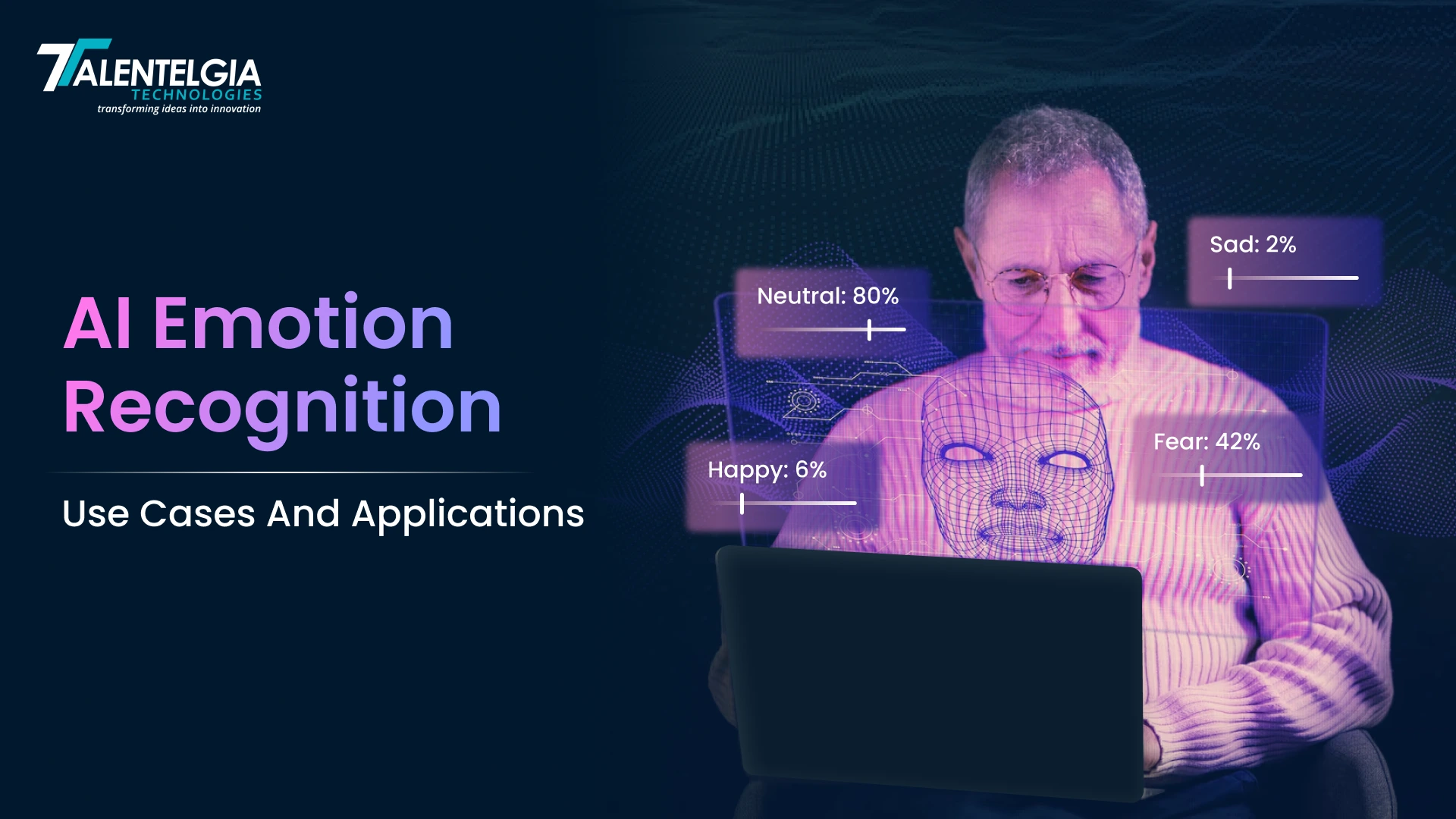

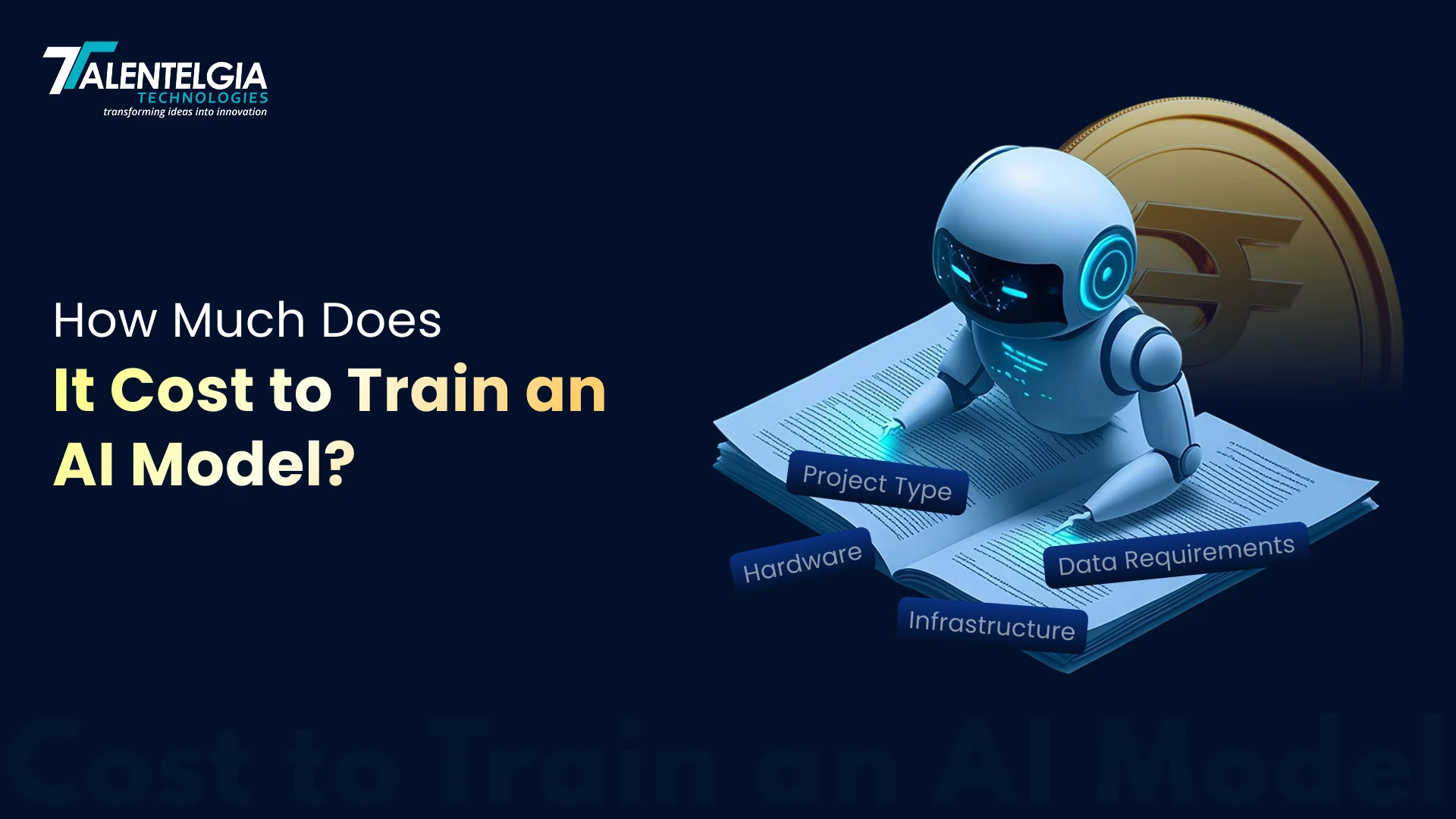

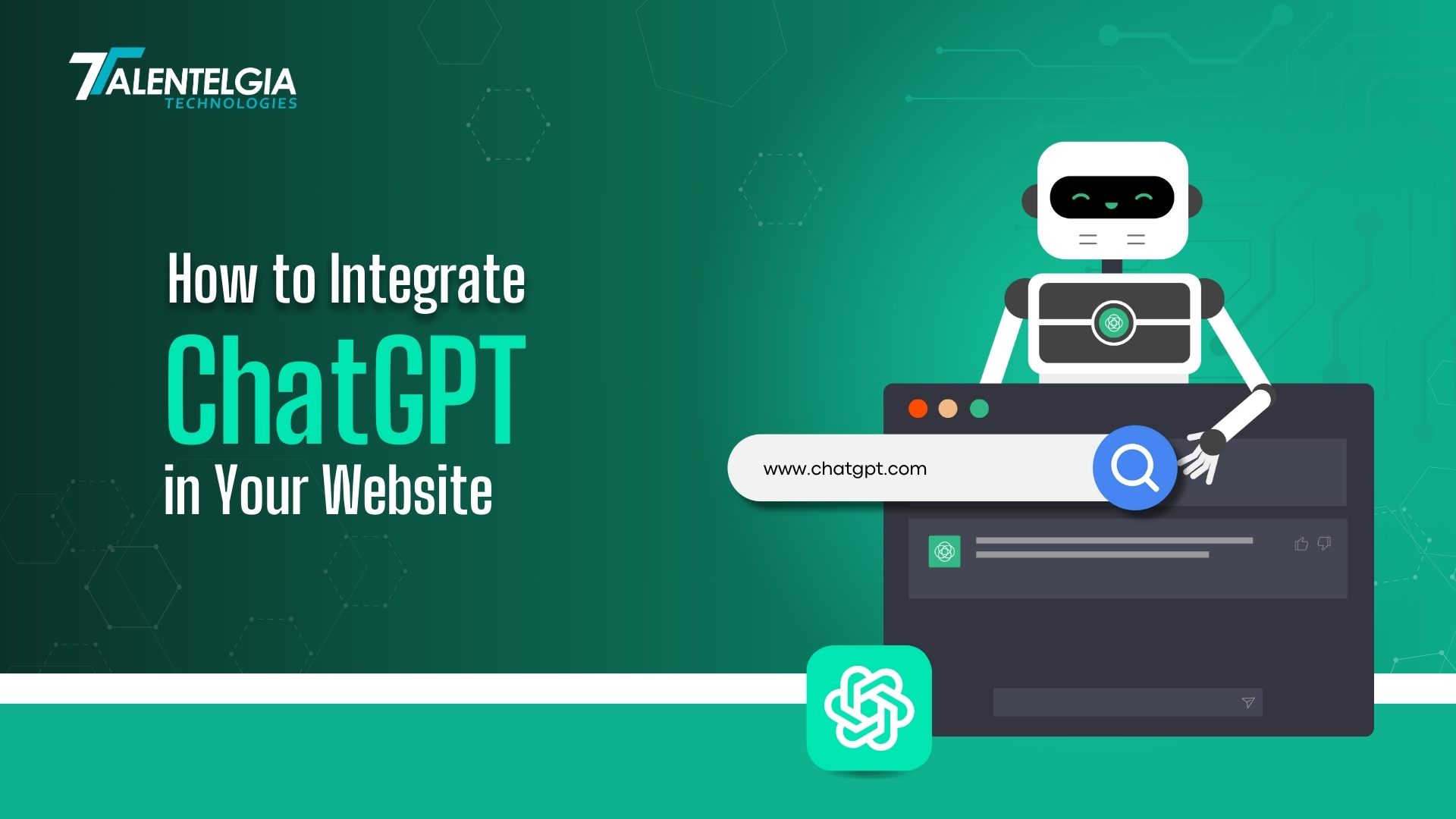

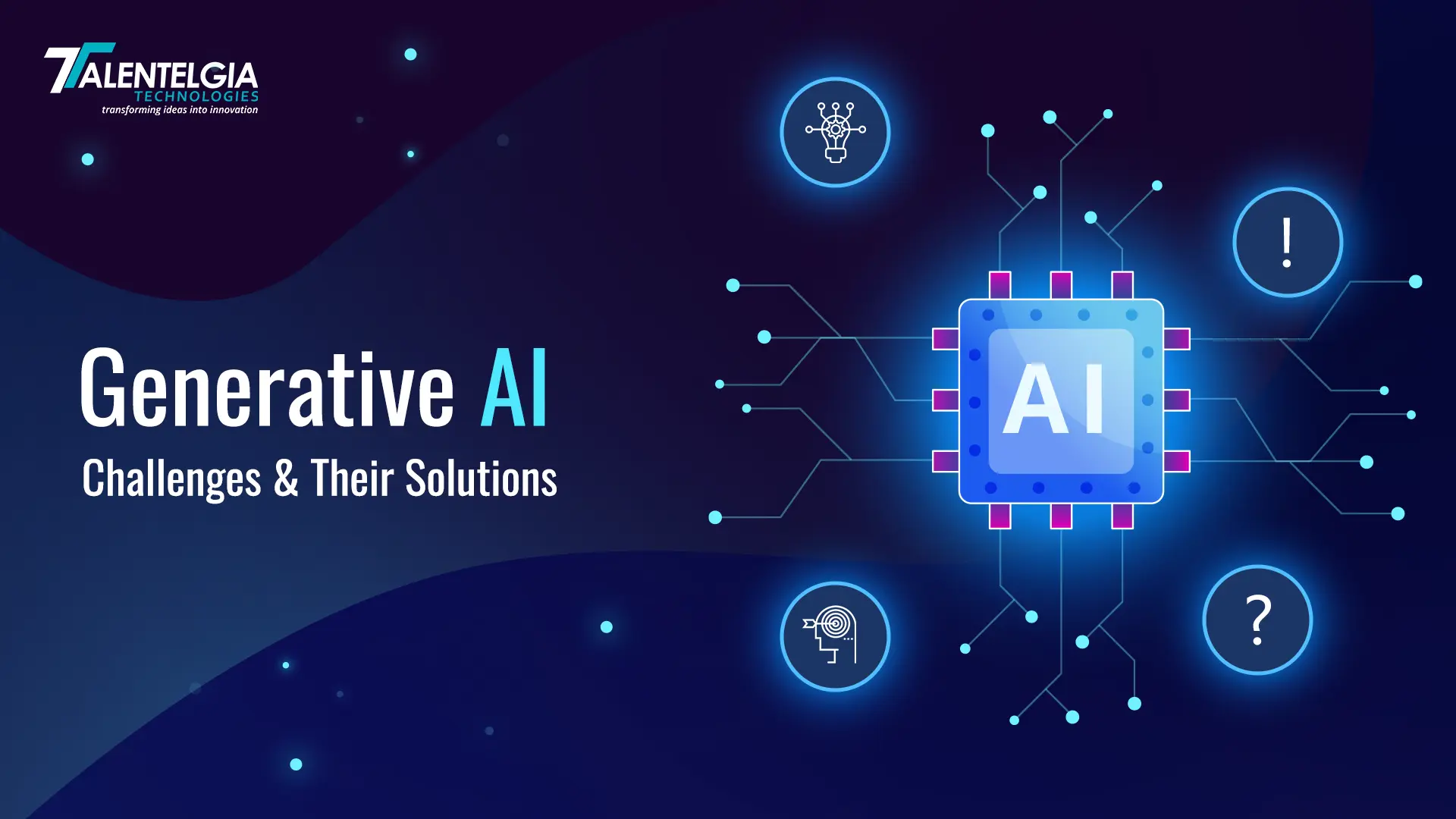











 Write us on:
Write us on:  Business queries:
Business queries:  HR:
HR: 





